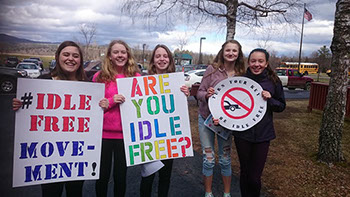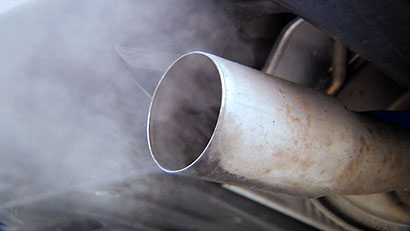MENU

Sacramento County
Idle-Free Schools
Sacramento County Idle-Free Schools, an Idle-Free California Inc. funded project, was implemented by Idle-Free California during the 2017-18 school year. Following recruitment of interested science, math, social science, social studies, STEM, and environmental studies teachers — with approval of school administrations — two middle schools within the Unified School Districts of Sacramento County participated in long-term, student-led studies/campaigns that addressed the health, climate, and energy impacts of vehicle idling on school grounds. Idling “hot spots” are a common occurrence at many schools, for instance when parents sit in their vehicles with engines running while waiting for students during afternoon pick up.1

These studies/campaigns promote science, mathematics, and project based learning by engaging students in a before and after study of idling vehicles; they further provide students with the opportunity to learn how to run a public service campaign and empower them to make a positive difference in the school community.
These campaigns are modeled on the excellent EPA Region 8 Idle Free Schools Toolkit.
Note: Participating school parents, PTOs or school parent clubs are also encouraged to participate!
1These campaigns do not address idling of school buses as California already regulates the idling of school buses and other heavy-duty vehicles.
Why an idle-free schools project?
• The U.S. EPA states: "Idling vehicles contribute to air pollution and emit air toxins, which are pollutants known or suspected to cause cancer or other serious health effects. Monitoring at schools has shown elevated levels of benzene, formaldehyde, acetaldehyde and other air toxics during the afternoon hour coinciding with parents picking up their children. Children’s lungs are still developing, and when they are exposed to elevated levels of these pollutants, children have an increased risk of developing asthma, respiratory problems and other adverse health effects. Limiting a vehicle’s idling time can dramatically reduce these pollutants and children’s exposure to them."

• The California legislature, in 2016, adopted ACR 160, a resolution that addresses the issue of vehicular air pollution. Specifically, it encourages motorists to not idle their motor vehicles near places where children congregate. This resolution lists many compelling reasons to avoid idling at schools or just about anywhere.
• In addition to the benefits in idling reduction these efforts provide, (1) students learn organizational, analytical and communication skills as they perform data analysis, are empowered by showing drivers the significant benefits in shutting off engines when parked, and take pride in making a positive difference in their school community, and (2) motorists learning of the benefits potentially apply them beyond schools.
Idle-Free California, previously Idle-Free Vermont, has successfully implemented idle-free schools campaigns in Vermont for several years. In the 2015-2016 school year, participation yielded a 41% reduction in idling.
Shelburne Community School campaign.
How do our Idle-Free Schools campaigns work? Visit the California Idle-Free Schools page for complete details!
SCHOOLS CAMPAIGNS 2017-2018
View on non-mobile device
for more details
ORANGEVALE OPEN K-8 SCHOOL
Fair Oaks - San Juan Unified School
District
Leaders/teachers: Aaron Silberman, 7th &
8th grade science
Step 1: introductory session conducted
Oct. 3rd
Step 2: initial data collection conducted
for four days at school afternoon
dismissal on 11/27, 11/28, 11/29, 11/30
Average temperature: 68 degrees
Total vehicles observed: 67; total vehicles
idling: 60 (92.5%); total minutes of idling:
1239 = 20.65 hours
Amount of fuel consumed*: 8.88 gal/four
days / 2.22 gal/per day average
Amount of fuel consumed annually (est.) -
based on 175 day school year: 389 gal
Amount of CO2 emissions annually (est.) -
based on 175 day school year: 7,770
lbs**
Step 3: school supports idle-free
campaign: NEWSLETTER IMAGE OF
Step 4: driver contact event 3/20 & 3/23
IMAGE 1 IMAGE 2 IMAGE 3 IMAGE 4
KFBK NewsRadio Sacramento 3/20 report/
interviews on campaign:
Step 5: final data collection conducted for
four days at school afternoon dismissal
on 5/15, 5/16, 5/17, 5/18
Average temperature: 74 degrees
Total vehicles observed: 129; total
vehicles idling: 72 (56%); total minutes of
idling: 796 = 13.3 hours
Amount of fuel consumed*: 5.7 gal/four
days / 1.4 gal/per day average
Amount of fuel consumed annually (est.) -
based on 175 day school year: 250 gal
(499 gal reduction relative to # of vehicles
observed, initial vs final)
Amount of CO2 emissions annually (est.) -
based on 175 day school year: 4,992
lbs** (9,980 lbs reduction relative to # of
vehicles observed, initial vs final)
BEFORE & AFTER IDLING DIFFERENCE:
67% REDUCTION (relative to the number
of vehicles observed and gallons
of fuel consumed - initial vs final
measuring)
KATHERINE L. ALBIANI MIDDLE SCHOOL
Elk Grove
Elk Grove Unified School District
Leaders/teachers: Katena Sanford and
Korena Hendryx, 8th grade science
Step 1: introductory session conducted
Nov. 9th (two classes)
Step 2: initial data collection conducted
for three days at school afternoon
dismissal on 11/13, 11/14, 11/15
Average temperature: 64 degrees
Total vehicles observed: 126; total
vehicles idling: 65 (51%); total minutes of
idling: 975 = 16.25 hours
Amount of fuel consumed*: 11.29 gal/
three days / 3.76 gal/per day average
Amount of fuel consumed annually (est.) -
based on 175 day school year: 658 gal
Amount of CO2 emissions annually (est.) -
based on 175 day school year: 13,160
lbs**
Step 3: school supports idle-free
campaign: SCHOOL WEBSITE NO IDLE
Step 4: driver contact event conducted
2/20 & 2/21 (photos of event not
allowed)
Step 5: final data collection conducted for
three days at school afternoon dismissal
on 4/30, 5/1, 5/2
Average temperature: 71 degrees
Total vehicles observed: 79; total vehicles
idling: __ ; total minutes of idling: ___ =
__ hours
Amount of fuel consumed*: ____ gal/three
days / ____ gal/per day average
Amount of fuel consumed annually (est.) -
based on 175 day school year: ___ gal
Amount of CO2 emissions annually (est.) -
based on 175 day school year: ______
lbs**
DATA INCOMPLETE. Explanation from
school: Students not given permission to
be dismissed early to observe
vehicles waiting prior to dismissal.
Students could only observe vehicles from
the time of dismissal when vehicles in
line slowly move forward to school
entrance.
To address this issue, participating
schools in future efforts must agree to
allow students to conduct observations at
least 15 minutes prior to dismissal.
*Amount of fuel consumed based on passenger vehicle — car/SUV/pickup truck — idling consumption of 0.43 gal/hr.
**Amount of CO2 emitted based on one gallon of fuel consumed equaling 20 pounds of CO2 emitted (gasoline - 19.64 pounds; diesel - 22.38 pounds)